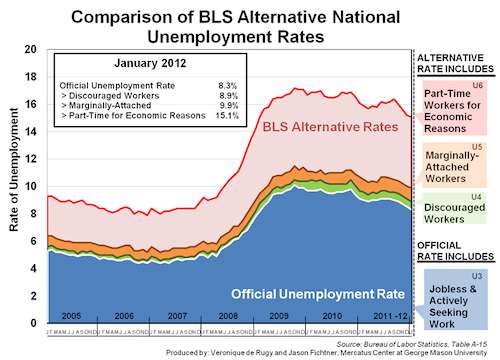- | Government Spending Government Spending
- | Data Visualizations Data Visualizations
- |
Comparison of BLS Alternative National Unemployment Rates
This chart provides a comparison of the official unemployment rate reported by the media with alternative measures of the unemployment rate reported by the Bureau of Labor Statistics (BLS).
This week Mercatus Center Senior Research Fellows Veronique de Rugy and Jason Fichtner provide a comparison of the official unemployment rate reported by the media with alternative measures of the unemployment rate reported by the Bureau of Labor Statistics (BLS). Data from the BLS is used to assess labor market conditions from several perspectives.
The most commonly reported unemployment rate – 8.3% in January 2012 - includes the number of people without jobs who are available to work and are actively seeking work in the four weeks preceding the survey as a percentage of the labor force (the sum of employed and unemployed persons in the economy). While this official unemployment rate remains the primary measure of labor market performance, there are reasons to believe that it is not the most realistic representation of the current state of the economy.
For instance, the BLS’ alternative measures depicted in the chart above provide three scenarios which build off this official definition of unemployment. As more factors are considered, the BLS’ unemployment rate grow in magnitude and, in effect, paint increasingly more realistic pictures of the extent to which the economy is not fully utilizing its labor resources. For example, in January 2012, 2.8 million persons were marginally attached to the labor force. These individuals were not in the labor force, wanted and were available for work, and had looked for a job sometime in the prior 12 months. However, they were not counted as unemployed because they had not searched for work in the four weeks preceding the survey.
The base of the chart shows the official unemployment rate (U3: blue portion). When discouraged workers (persons not currently looking for work because they believe no jobs are available for them) are added to this base as a percent of the civilian labor force, the unemployment increases slightly (U4: green portion). When all other marginally attached workers are further added to this number as a percentage of the civilian labor, the unemployment rate number climbs yet a little higher (U5: orange portion).
When the total number of people employed part-time for economic reasons (those working part time because their hours have been cut back or because they are unable to find a full-time job) are added to the total number of (i) unemployed persons, (ii) discouraged workers, and (iii) all marginally attached workers, as a percentage of the civilian labor force, the unemployment rate soars above the official unemployment rate (U6: red portion). This last scenario provides a more accurate measure of the climate in the labor market.
This alternative measure (U6) has remained above 10 percent since June 2008. Most recently, in January 2012 the reported official unemployment rate was 8.3%. After including the impact of discouraged workers, marginally attached workers, and those working part time for economic reasons, the rate drastically increases to 15.1%, or nearly twice the official unemployment rate.
During the three years prior to 2008, the official unemployment rate remained between 4.4% and 5.4% with a 1% fluctuation (at most) in percentage terms; the gap between the alternative rate and official rate remained under 4 percentage points. As unemployment surged in the beginning of 2008 and 2009 by twice the average annual rate from the previous three years, the gap between the alternative and official rates also grew larger. This gap grew to 6.2% by the end of 2008, 7.0% by the end of 2009, and peaked at 7.4% in 2011.
Despite the stark increase in unemployment since 2008, it matters not where the line ends – currently at 8.3% (official) and 15.1% (U6 alternative) - but rather the lack of any meaningful, sustained improvement for more than two years.
Veronique de Rugy discusses the unemployment rate at National Review Online’s The Corner.
Jason Fichtner proposes solutions to increase employment and economic growth in a testimony before the U.S. Senate Committee on Finance.

